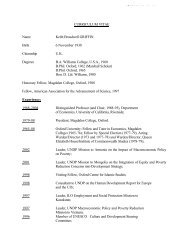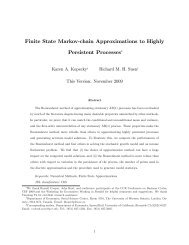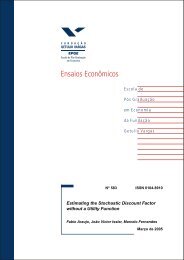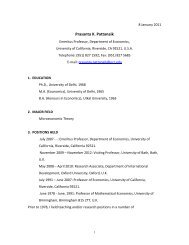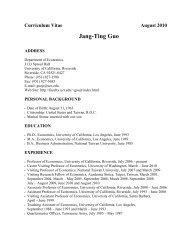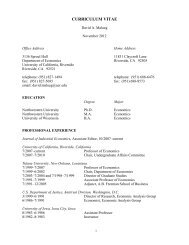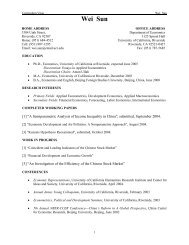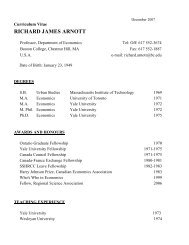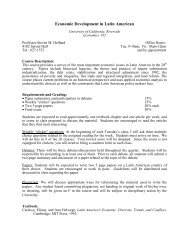Copula-based Multivariate GARCH Model with ... - Economics
Copula-based Multivariate GARCH Model with ... - Economics
Copula-based Multivariate GARCH Model with ... - Economics
Create successful ePaper yourself
Turn your PDF publications into a flip-book with our unique Google optimized e-Paper software.
4.2.2 Likelihood for Method 2<br />
For m =3, the (conditional) joint PDF function of η t is<br />
f 123 (η 1 ,η 2 ,η 3 ) ≡ ∂3 F 123 (η 1 ,η 2 ,η 3 )<br />
∂η 1 ∂η 2 ∂η 3<br />
(22)<br />
= ∂3 C(F 1 (η 1 ),F 2 (η 2 ),F 3 (η 3 ))<br />
∂η 1 ∂η 2 ∂η 3<br />
= ∂3 C(F 1 (η 1 ),F 2 (η 2 ),F 3 (η 3 ))<br />
∂u 1 ∂u 2 ∂u 3<br />
· ∂F 1(η 1 )<br />
∂η 1<br />
· ∂F 2(η 2 )<br />
∂η 2<br />
· ∂F 3(η 3 )<br />
∂η 3<br />
= c(u 1 ,u 2 ,u 3 ) · f 1 (η 1 ) · f 2 (η 2 ) · f 3 (η 3 ).<br />
Note that for the 3-variate distribution we need the 3-variate copula function for Method 2 (while<br />
we only need bivariate copulas for Method 1). The log-likelihood function can be obtained similarly,<br />
from (18), (19), and (22).<br />
5 Empirical Analysis<br />
The objective of this section is to compare the C-M<strong>GARCH</strong> models <strong>with</strong> the conventional M<strong>GARCH</strong><br />
models in terms of in-sample estimation and OOS forecasting. To elucidate the effect of the distinct<br />
feature of the C-M<strong>GARCH</strong> model, we adopt the same normal marginal distribution so that the<br />
difference arises only from the copula density.<br />
We examine three foreign exchange (FX) rate series (in U.S. dollars) — French Franc (FF),<br />
Deutschemark (DM), and Italian Lira (IL). The return series are 100 times the log-difference of<br />
the exchange rates. The daily spot FX series are from the Federal Reserve Statistical Release. The<br />
entire sample period that we consider is daily from 1993 to 1997 <strong>with</strong> T = 1256 observations. We<br />
split the sample in two parts. The in-sample estimation period is from January 4, 1993 to December<br />
31, 1996 (R ≡ 1005 observations). The OOS forecast validation period is from January 5, 1997 to<br />
December 31, 1997 (P ≡ T − R = 251 observations).<br />
We use the “fixed scheme” for which we estimate the parameters at t = R (December 31, 1996)<br />
using the sample of size n = R, andfix the parameters at these estimated values (no updating)<br />
to make one-day-ahead density forecasts throughout the total P = 251 days in 1997. 9 The results<br />
are presented in Tables 1-4, <strong>with</strong> in-sample estimation results in Panel A and the OOS forecasting<br />
results in Panel B.<br />
9 The parameters β ∗ t−1 can be estimated <strong>based</strong> on the whole subsample {r t−1 ,...,r 1 }, a rolling sample<br />
{r t−1,...,r t−R} of size R, or a fixed sample {r R,...,r 1} at the end of the in-sample. We use the fixed scheme<br />
in this paper. See West and McCracken (1998, p. 819) for more discussion on these three forecasting schemes.<br />
14




